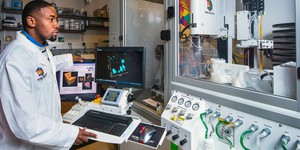Summary
If you want a Project Idea with full instructions, please pick one without an asterisk (*) at the end of the title.
Abstract
Walk into any music store and you'll find a dizzying array of string choices for your classical guitar, including rectified nylon, clear nylon, carbon fluoride, bronze wound, phosphor bronze wound, silver-plated copper wire, Polytetra-flouro-ethylene (PTFE), each in a range of tensions from low to high. There is no single best brand or best material. All have their advantages and disadvantages. A set of strings that sounds "sparkling" on one guitar might sound dull on another, primarily because each guitar has its own individual soundboard, made of a special tonewood, which interacts with the vibrations from the strings in a unique way.In this music science fair project, you will investigate the best guitar string material for your guitar. You will first need to read about the different materials, and then select three different types of strings, all of the same tension, to test. You will then to read about harmonics and overtones and the difference between them. A plucked string has an almost harmonic spectra, meaning that when you looked at its frequency spectrum or sound spectrum, you will see a series of peaks at approximate multiples of the fundamental frequency. For example, if you pluck an A-string with a fundamental frequency around 440 Hz, then you will see a series of peaks at approximate multiples of 440 Hz; that is, at 440, 880, 1320, and 1760 Hz, etc.
In your science fair project, you will first need to decide which open string to test. You can choose any string you want, but the G-string, the third highest pitch of the six strings, is a unique case. This string is notorious for being difficult to tune and get good intonation from on a guitar. Many researchers have found that the newer carbon materials have been an improvement for the G-string. This might be something you want to investigate. Whatever string you choose, you will first need to put a test string on your guitar in the proper placement for that string, tune it with a guitar tuner, and then make open-string recordings (pluck the string several times without putting any fingers down on the finger board). You can then process your sound recordings using any free or commercial piece of sound editing software that has a spectrum analyzer. The Bibliography provides open-source software, which has a "spectrogram mode" for visualizing frequencies, and a "plot spectrum" command for detailed frequency analysis.
As you pluck the open strings, note how each string sounds to you in your lab notebook: Is it pure? Rich? Warm? Crisp? Which sound did you like best on your guitar? Then go back and compare the spectra of the different strings to see which have the most or strongest overtones and which are the most pure.
Bibliography
This source describes the different types and properties of classical guitar strings:
- Prisloe, T. (2002). How to Select the Best Classical Guitar Strings for Your Nylon String Guitars. Retrieved October 13, 2008.
This source gives a general overview of classical guitar strings:
- Wikipedia Contributors. (2008, August 17). Classical guitar strings. Wikipedia: The Free Encyclopedia. Retrieved October 13, 2008.
This source discusses the difference between harmonics and overtones:
- Wikipedia Contributors. (2008, August 17). Overtones. Wikipedia: The Free Encyclopedia. Retrieved October 13, 2008.
This source describes what a fundamental frequency and its harmonics are:
- Wolfe, J. (2006). What is a sound spectrum?. Retrieved October 13, 2008.
This source describes the physics of plucked strings:
- Wolfe, J. (2006). Strings, Standing Waves, and Harmonics. Retrieved October 15, 2008.
This link provides free, "open-source" software with the capability for sound editing and frequency-spectrum analysis:
- Audacity Developer Team. (2000, May). The Free, Cross-Platform Sound Editor. Retrieved October 16, 2008.
Ask an Expert
Careers
If you like this project, you might enjoy exploring these related careers:









